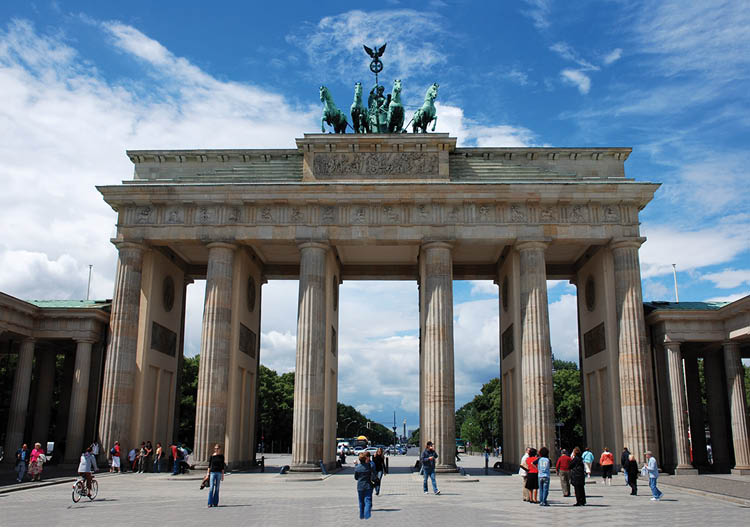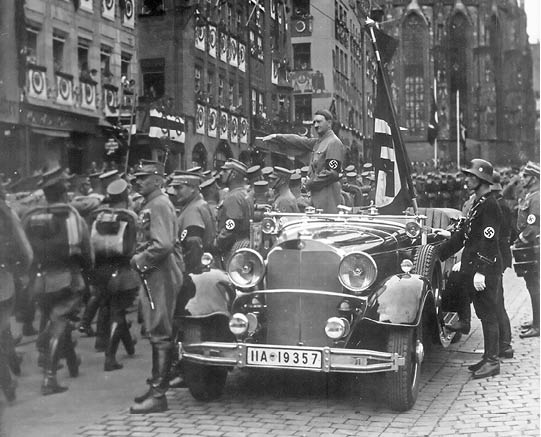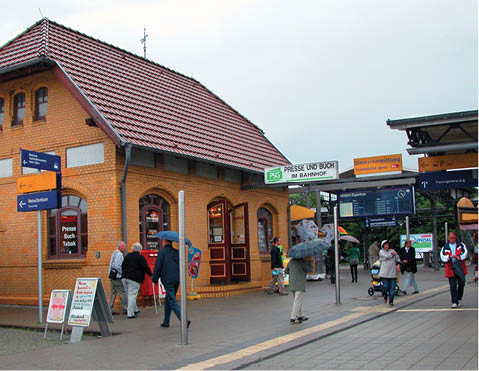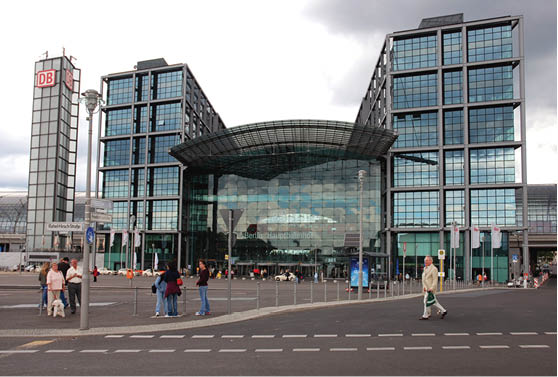Germany


Brandenburg Gate
Twice in the 20th century Germany rose to prominence as a formidable nation, and twice it came crashing down, destroyed in part by its own hubris. German intellectuals have helped shape Western philosophy since the Middle Ages, but the road to democracy has been a tortuous one for the German people.
The first German Empire, which lasted 47 years, was founded in 1871 under the leadership of Prussian chancellor Otto von Bismarck. Prior to this, centralized authority had eluded Germany since the dismantling of the medieval Carolingian Empire and the subsequent emergence of powerful German duchies. For centuries Germany remained a patchwork of free cities and principalities ruled by merchant princes. Prussia eventually became the most powerful German state, ruled by William I and Bismarck. After Prussia defeated Austria in 1866 and France in 1871, William I was proclaimed Kaiser (emperor) of all Germany.
Map of Germany

The newly formed German Empire quickly became one of the world’s most powerful industrial economies and a commercial rival of Britain. Germany also expanded its navy to challenge British supremacy at sea. But the incompetent leadership of Kaiser Wilhelm II brought humiliating defeat to Germany in World War I and he was forced into exile, leaving a vanquished Germany struggling to recover under the Weimar Republic.

Hitler saluting his Nazi troops at Nuremberg in 1935.
In 1933 after gaining the largest share of seats in the Reichstag, Adolf Hitler was appointed Chancellor and within weeks seized power in Germany as leader of the Nazi party. A dictator whose name has become synonymous with evil, Hitler perverted the teachings of various German philosophers, including Nietzsche, to justify Germany’s “will to power” that would set it apart from the masses of inferior humanity and create an Aryan master race. The Third Reich plotted a course for European domination that was doomed to fail and its aftermath is still keenly felt, especially in the capital of Berlin. As the city rebuilds following its post-Cold War reunification, Berliners are also coming to terms with the past. Historic sites associated with Nazi atrocities and Soviet oppression are being turned into powerful memorials to the victims of totalitarian regimes, and Berlin today is filled with youthful energy and social tolerance.

Great beer is just one of the attractions of Germany.
Germany is a mostly land-locked country with the exception of its north coast, which borders both the North Sea and Baltic Sea. Here lie the country’s major ports as well as numerous small ports and islands visited by small cruise ships. These include the Pomeranian port of Stralsund and Ruegen Island in the Baltic, and the port of Cuxhaven and Sylt Island along the North Sea coast.
The country’s population of 80 million is the second highest in Europe after Russia. The German economy is Europe’s largest, and considerable funds have been spent since 1990 in an attempt to raise productivity and wages in the former East Germany to the same level as the rest of Germany.
Although German is the official language, English is widely spoken by the younger generations and shopkeepers. One-third of the population is Protestant, another third is Catholic, and the remainder is either unaffiliated or belongs to other religions.
Germany (called Deutschland in German) is a federal republic with a chancellor serving as head of government. The current German chancellor, Angela Merkel, was elected in 2005 and grew up in East Germany. Unity Day – October 3 – is a national holiday and celebrates Germany’s 1990 reunification. Berlin (pop. 3.5 million) is the capital of a united Germany. During the Cold War, East Berlin was the capital of East Germany and Bonn was the de facto capital of West Germany. Today, the capital is Berlin. Germany’s currency is the euro.
The colours of the German flag (black, red and gold) can be traced to the medieval banner of the Holy Roman Emperor (the elected king of Germany), which displayed a black eagle with red claws and beak on a gold field.
Traditional German cuisine is known for its heavy use of bratwurst (pork sausage) and liverwurst (liver sausage), usually served with rye bread and washed down with a schooner of wheat beer. Classic German dishes include spaetzle (egg noodles or dumplings) and wiener schnitzel (breaded veal cutlets). Popular desserts include stollen (fruit cake), apple strudel and baumkuchen, meaning ‘tree cake’ in German for this round cake’s layers of batter are added one by one on a spit and resemble the growth rings of a cut tree when the cake is sliced. Modern German cuisine is lighter than traditional German cooking, and in northern Germany fish is often featured on the menu.

Warnemünde’s train station.
The seaside resort of Warnemünde lies at the mouth of the River Warnow and marks the entrance to Rostock’s seaport, which is a major terminus for cargo ships and car ferries. This is a major Baltic port of call providing access to Berlin and other area attractions such as Lübeck city and the bucolic Mecklenburg countryside. Rostock was an important member of the Hanseatic League and is worth exploring for its medieval architecture and pedestrian streets lined with gabled buildings.
Most cruise ships dock at the Warnemünde Cruise Centre, which is a five-minute walk to the town centre and local train station. The train trip to Rostock is 20 minutes and a single-trip ticket costs 1.8 euros. Rostock Cards are sold in the Warnemünde Cruise Terminal and cost 12 euros each. This non-transferable card entitles you to free public transport in the Rostock area, including the train from Warnemünde to Rostock as well as the metro, trams and buses in Rostock, and free entrance to some of the city’s museums and other attractions.
The Warnemünde-to-Rostock train makes eight stops before arriving at Rostock Hauptbahnhof (Central Station). To reach Berlin by train, you must change trains at Rostock. A single traveler ticket from Rostock to Berlin is about 80 euros (round-trip, 2nd class) and the train ride is about 2.5 hours. You arrive at Berlin’s Hauptbahnhof, close to the Reichstag. Assuming you caught the early-morning train, you will have three or four hours to spend in Berlin before catching a train back to Rostock, and from there to Warnemünde.

Warnemünde’s harbourfront.
The seaside resort of Warnemünde (pop. 8,500) began as a fishing village before it became a seaport for the merchant city of Rostock in 1323. The village’s beautiful beaches – stretching for two miles – began attracting holidaymakers in the 19th century, making Warnemünde one of the first German seaside resorts. The wicker beach chair was invented here when a woman asked a basket maker to make her a beach chair with a waterproof hood that also served as a sunshade.
Map of Rostock & Area

Warnemünde’s attractions are clustered around Alter Strom (old channel) which is lined with traditional fishermen’s houses on one side and a fishing quay on the other. Am Stam stretches along the harbourfront and is lined with shops and cafes, as is the street directly behind it. Both lead to the lighthouse, built in 1898, which has panoramic views at the top. Beside it is the Teepott – an example of East German architecture from the 1960s – which houses a restaurant and ground-floor seafaring exhibit. The local casino is in the Kurhaus, a Bauhaus-style building near the beachside promenade. Other attractions in Warnemünde include the neo-Gothic church completed in 1872, its original altar dating from 1475.

Steintor city gate in Rostock.
Rostock (pop. 200,000) was originally a Slavic fortress called Roztoc (‘broadening of a river’). Torched in 1161 by the Danish king Valdemar I and afterwards settled by German traders, Rostock became a prosperous member of the Hanseatic League and founded a university in 1419. Rostock was part of Swedish Pomerania (a dominion under the Swedish crown) from the mid-1600s until the end of the Napoleonic Wars when it was transferred by treaty to Prussia.
Map of Rostock

During the Second World War, Rostock was heavily bombed by Allied planes that were targeting the city’s aircraft factories. Many of Rostock’s medieval monuments have been rebuilt, and a visit to the historic centre is an opportunity to view numerous examples of Gothic brick architecture.

Rostock’s City Hall.
1. City Hall (Rathaus) – Compact enough for walking, Rostock’s historic centre is about a 15-minute walk from the main train station. Trams also depart regularly from the train station (Trams #5 and #6 stop at centrally located Neuer Markt) and taxis are available outside the train station. Neuer Markt (New Market) is a bustling square lined with gabled buildings and filled with open-air markets and outdoor cafes. City Hall (Rathaus) overlooks the square and has been the seat of Rostock’s city administration for more than 700 years. Its rooftop consists of Gothic turrets and its baroque façade was added in the early 18th century.
2. Marienkirche (St. Mary’s Church) – This church stands at one corner of the square, its construction dating to the 13th century. It contains numerous late Gothic artifacts, including an astronomical clock and bronze baptismal font.

Kropeliner Strasse.
3. Universitatsplatz – Kropeliner Strasse is a pedestrian street lined with shops and restaurants that leads from Neuer Markt to Universitatsplatz where the University’s main building (a neo-Renaissance structure completed in 1867) overlooks the bustling square.
4. Cultural History Museum – A statue of the Rostock-born Prussian Field Marshall Blucher, a hero of the Napoleonic Wars, stands in one corner of the square, beyond which is Rostock’s Cultural History Museum housed in the Holy Cross Convent where Cistercian nuns once lived and worshipped.

Rostock University.
5. Kropeliner Tor (Kropeliner Gate) – One of the original 22 gates that once stood along the walls encircling Rostock, remnants of which run alongside Wallaniagen Park to Rosengarten (Rose Garden).
6. Standehaus (Guild Hall) – Overlooking Rose Garden is the red-brick Standehaus (Guild Hall) built in 1893 and now serving as a local courthouse.
7. Steintor – A city gate built in the Dutch Renaissance style located on the site of the town’s original main southern gate.
8. Nicholas Church – Richard Wagner Street leads south from Steintor back to the train station, while Beginenberg Street leads east toward Nicholas Church, a 13th-century Gothic church now serving as a concert hall with apartments built into the roof.

St. Peter’s Church
9. Petrikirche (St. Peter’s Church) – This church is perched on a hill overlooking the harbour, its site marking the town’s original settlement. Built in the mid-14th century to replace an earlier church, Petrikirche was badly damaged by World War II bombings and its steeple was reconstructed in the 1990s. An elevator (2 euros per person) can be taken to a viewing platform at the top of the church’s steeple overlooking the harbour.

Berlin’s Hauptbahnhof.
Berlin has become a hot destination since the end of the Cold War. Following reunification in 1989, Berlin’s affordability attracted aspiring young artists and the city became one of Europe’s most vibrant cultural scenes with its modernist architecture and trendsetting design studios. The words “übercool” and “edgy” are still used to describe Berlin these days, although some say the rapid gentrification of East Berlin is turning it into a collection of bourgeois neighbourhoods. Nonetheless, Berlin’s legendary music halls and nightclubs provide some of the most exciting nightlife in Europe.